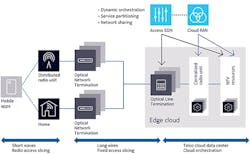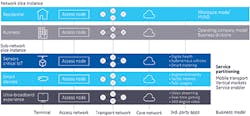Think Global, Act Local
Fixed Access Network Transformation at the Edge Cloud —
The digital era offers an unprecedented opportunity for fixed and mobile operators. Large-scale network connectivity and high-speed broadband access have brought global reach to consumers and businesses. In this hyper-connected digital economy, embracing the Cloud has proven to be key for companies to remain relevant. The cloud has profoundly revolutionized how many contemporary businesses operate in and react to ever-changing marketplaces.
Software platforms and Cloud-based infrastructures are clearly at the heart of these business model disruptions, enabling the on-demand flexibility and online availability customers require. This doesn’t mean centralization is a panacea for delivering a rich high-speed broadband experience to more people anytime and anyplace. In order to cost-efficiently support high-bandwidth demands beyond 1 Gb/s and latency-sensitive applications such as IoT and 5G, it’s increasingly important for operators to have real estate close to subscribers to support performant and secure networks with global reach.
The combination of local and global enablers is a universal concept that applies to both fixed and mobile access network technologies. Software-defined access networks seek to provide such balance: optimized physical network functionality is hosted close to end users for performance and non-real-time functions, such as control and service layers, are centralized on flexible software-defined architectures based on the latest data-center technologies. (See Figure 1.)
Figure 1. Local is the new global in the digital era.
Fixed Access Network Transformation at the Edge Cloud
In a multi-technology and multi-operator environment, fixed operators face difficulties managing and expanding their access infrastructure while at the same time keeping costs under control. The ideal answer to this challenge is software-defined access networks (SDAN), where the principles of software-defined networking (SDN) and network function virtualization (NFV) are applied in fixed networks.
SDAN virtualizes the intelligence of the network and centralizes it in software running on top of general purpose hardware. The network can then be programmed and controlled from the Cloud. The open nature of SDAN creates a new approach to hardware management that dramatically reduces costs and renews an operator’s ability to scale.
With virtualization, network functions can be run in the Cloud and scaled elastically in response to demand. The location where the function runs is also flexible, and functions can now be distributed to the edge of the network, hence the term Edge Cloud. This allows an optimal trade-off between latency and data center consolidation.
By adopting data center principles in their local real estate, operators turn their central offices (COs) into Cloud COs, complementing the core Cloud to form a multi-layer Cloud infrastructure. This new paradigm lets operators rethink the design of COs, bringing forward new network architectures that offer both traditional connectivity and Cloud services for residential, enterprise, and mobile customers.
Anyhaul and Cloudification for 5G
5G networks are expected to employ, to a large extent, Cloud radio access networks (CloudRAN). In these architectures, the digital data processing functions are divided among central units and distributed units at the antenna sites. Depending on the specific functional split of the processing chain, the resulting anyhaul interface (anyhaul = backhaul, midhaul, fronthaul, or next-generation fronthaul) will impose substantially different requirements on capacity, traffic dynamics and latency of the fixed network connecting the central and distributed units.
Massive centralization brings economies of scale but it doesn’t overcome physics as time and bandwidth are required for data to travel between antenna sites and the Cloud. By deploying various services and caching content at the network edge, metro and core transport networks are alleviated of further congestion by bandwidth hungry applications.
The European Telecommunications Standards Institute (ETSI) has called this concept multi-access edge computing (MEC). It fosters an open environment for the adoption of IT and Cloud-computing capabilities within the radio access network. MEC differentiates services and new applications by deploying computing capacity at the network edge. This network edge can co-exist with other virtualized network functions and be hosted in the same Cloud COs. Like this, latency is significantly reduced, enabling operators to introduce data center practices that deliver an ultra-responsive experience.
Joining Forces for 5G
Long Term Evolution, LTE Advanced (pro) (4.x) and 5G standards introduce new CloudRAN architectures and new interfaces with a new set of requirements, challenging transport networks to deliver more capacity at lower delays.
We have reached a point where mobile operators cannot efficiently meet rising demand without relying on fixed broadband networks. Operators realize that RAN network modernization requires innovative fiber transport solutions in order to keep costs under control. The most resource efficient approach for mobile transport is leveraging fiber-to-the-home (FTTH) networks in areas where 5G capacity will be needed the most.
Fiber access networks are thus becoming a strategic differentiator for mobile services. Owner-operators of mobile networks can benefit from closer collaboration with fixed network operators because they face a very complementary set of challenges. Both types of network must keep pace with increasing demand: more subscribers, generating more traffic and wanting faster connections.
On the fixed front, fiber is being brought closer and closer to end-users. The resulting increase in street cabinets and nodes perfectly matches the cell densification strategy being pursued by mobile operators. By joining forces, the 5G mobile transport network is already in place: fixed operators deliver faster network monetization and expedite their FTTH deployments; mobile operators have a cost-effective mobile transport solution in the areas where wireless congestion and expansion will occur.
Getting Your Head in the Cloud
The Cloudification of network layers that is occurring simultaneously in fixed and wireless networks further increases synergies between them. But it also brings significant challenges common to all Cloud-based applications.
Non-real-time application features and management functionality can be hosted in the data center, while the more time-critical functions can be hosted in a facility closer to end users. This requires a new way of working: vendors and service providers need to collaborate in open software frameworks and optimize end-to-end behavior across the network via programmable interfaces. This is where one of the key advantages of software-defined networking comes in.
The introduction of virtualized functions, centralized intelligence in the Cloud, and SDN programmable interfaces, enable the rapid creation, optimization, and termination of services needed in the 5G era.
In a 24-hour period, there is a clear complementary pattern between residential (indoor) peak use and mobile (outdoor) busy hours. For example, baseband processing power can be allocated to wherever there is most demand: residential areas in the evenings and business areas during working hours.
The Edge Cloud uniquely allows software applications to tap into local content and real-time information about access network conditions.
The central units of the fixed access domain run virtualized OLT (vOLT) functions and the central units of the mobile access domain run virtualized BBU (vBBU) functions. The same multi-level Cloud infrastructure can be shared, which improves the business case on both sides, fixed and mobile. With centralized intelligence, the fixed access network can be provisioned and optimized for mobile transport by coordinating with mobile network elements such as centralized self-optimizing network modules that automate operations across multiple domains. (See Figure 2.)
Figure 2. Fixed and mobile access Cloudification.
Network Slicing
Future access networks will no longer be designed for a single traffic type but for multiple types with different requirements. In order to support the increasing number of fixed and mobile use cases, network slicing creates a new way of sharing. It considerably transforms the networking perspective by isolating and abstracting the underlying set of infrastructure resources and network functions.
5G is a new radio access technology family. It expands to multiple dimensions by providing a common ground for numerous radio technologies (cellular, Wi-Fi, fixed), multiple applications, and multiple network operators.
The applications of 5G are usually segmented into 3 types:
Type 1. Enhanced mobile broadband (eMBB) for users offering Gigabit services whenever needed, with 10,000 times more traffic, ubiquitous availability, and high user-mobility.
Type 2. Ultra-reliable, low latency communications (URLLC) for mission-critical applications such as vehicle-to-x (V2X) or automated manufacturing (Industry 4.0). This requires guaranteed availability and reliability of the radio link as well as transmission latency values down to 1 ms.
Type 3. Massive machine-type communications (mMTC) providing radio links for huge numbers of sensors that only occasionally transmit small amounts of data, preferably with strongly reduced signaling overheads when compared to eMBB and URLLC.
One of the main effects on mobile transport will be to become more dynamic to handle different types of services, with widely varying requirements for mobility, reliability and latency, as explained above, as well as energy efficiency. For instance, enhanced mobile broadband will require huge capacity and video caching capabilities. Massive IoT will instead need high density but without mobility. And mission-critical applications will be more about low latency and high reliability.
To address the requirements of various 5G applications, the concept of network slicing is introduced: the 5G physical network is sliced into parallel and independent, logical end-to-end networks, with each slice dedicated to a specific set of requirements. This approach allows the efficient delivery of simultaneous services with widely differing needs for bandwidth, latency and reliability within a unified network deployment.
Operators also want the ability to monetize offerings to large customers and verticals whose devices or traffic may have specific service characteristics. On the transport side, this implies a need for increased service awareness and flexibility.
Fixed Access Network Sharing
In a fixed network, this service concept is achieved by Fixed Access Network Sharing (FANS), a technique that uses virtualization as a way of slicing the access network and providing independent control of each slice. In this approach, it is possible to self-operate and maintain network slice instances over multi-tenant APIs within the limits of service level agreements. FANS uses a new management model, based on NETCONF and YANG.
Fixed access infrastructure sharing has many applications. It allows multiple operators to share network infrastructure, increasing competition by lowering the cost barrier to entry or allowing network wholesaling business models. Deploying next-generation broadband to meet the growing demand for high-bandwidth services is a costly endeavor; cooperation strategies are important to decrease the investment risk and thus accelerate ultra-broadband deployments to fixed and mobile users.
The fixed access network will serve highly diverse types of communication (for example, between humans, machines, devices, and sensors) with different performance attributes. The independently managed slices of the network are perfect for delivering different business, residential or wireless services. (See Figure 3.)
Figure 3. One physical access network, many partitions.
Network operators need to be able to monitor and maintain the usage of the network slice instance with their own OSS based on the operations data received from the platform network via agreed and standardized NETCONF/YANG interfaces. Providing a flexible software-programmable network infrastructure gives greater granularity and dynamicity than engineered partitioning. For wireless traffic to reliably share capacity with residential network services, network element functions will need to be dynamically reconfigured in response to changing traffic patterns and the low latency needs of 5G applications.
Moreover, FANS ensures that mobile network operators run and operate mobile services independently on top of a virtual but dedicated fixed network infrastructure. It allows a mobile virtual network operator (MVNO) to serve its own customer base with its own core network functions while sharing the mobile transport with other mobile network service providers.
Convergence Makes Cents
Nokia continues to deliver ground-breaking innovations in products and professional services. The company’s fixed network solutions provide the optimal quality of experience, consistent with the business goals of the service provider, and can provide the lowest total cost of ownership by converging mobile transport services with today’s residential broadband networks. This is achieved through an unmatched flexibility in deployment models and massive scalability to accommodate growing traffic and base station numbers.
With fixed networks, everyone wins. A converged operator who owns both fixed and mobile assets will improve its business case. A mobile operator with plans to acquire or enter a joint venture with a fixed operator can then compete with incumbents. In addition, mobile operators already preparing for 5G can keep backhaul costs under control. Fixed operators have a catalyst for delivering faster network monetization and expediting FTTH deployments. And wholesale fixed operators can add high-revenue business and increase revenues.
It makes sense for all involved. And with "cents-able" solutions, the dollars will follow.
Save
Save
About the Author




